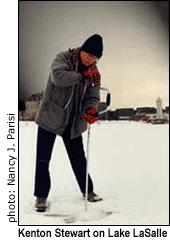| VOLUME 32, NUMBER 8 | THURSDAY, October 12, 2000 |
Lake-ice data appears in Science
Every winter and spring since the late 1960s, Kenton Stewart, professor of biological sciences, has been making calls and sending out postcards to people who live on the shores of hundreds of lakes in the United States, lakes with names like Oneida or Cazenovia in New York and Mooselookmeguntic in Maine. Every year, he asks them to tell him when their lake freezes in the fall or winter and when it opens or breaks up in the spring.
"Some of the lakes that I monitor in the states of New York, Maine, Minnesota and Wisconsin have been showing evidence of global warming for decades," said Stewart, who teaches limnology, the science of bodies of fresh water, at UB. "I thought that the same thing was probably happening at other lakes around the world, but wasn't sure until all of us brought our data together."
Stewart suspects that he monitors freeze/thaw cycles in more lakes than any other scientist in the world. He may have the largest scientific inventory of lake-ice dates in North America, covering more than 250 lakes in New York and several hundred in other states.
Since the late 1960s, Stewart has been studying lake-ice dates of an increasing number of lakes to see whether they can serve as proxy indicators of climate change.
Now that the point has been proven, Stewart would like to focus his work on how these data compare within a specific region. This would help determine how a particular region will fare as a result of climate change.
"Predicting future climate change is easier to do on a global scale than on a local or regional basis," he said. "We need a far more detailed look at the phenomenon."
Ironically, Stewart, like some of his co-authors on the Science paper, receives no funding to conduct his research. In the past, funding agencies have said that lake-ice dates do not demonstrate global climate change; hopefully, the Science paper will prompt those agencies to reconsider.
To gather the data, Stewart has for 30 years relied on a loyal ad hoc network of hundreds of lakeside observers with whom he makes contact every year to obtain lake-ice dates, and most of whom he has never met.
"People who live on the lakeshores notice ice events but very few people record them," said Stewart, who noted that finding and maintaining contact with people who will record them, especially in remote areas, is particularly challenging.
"People move, they go south for the winter and worst of all, they die," said Stewart.
When trying to identify contacts on a new lake, Stewart may try a local sporting-goods store, the town hall or the local police station. He often is referred from one person to another.
Not long ago, one of Stewart's phone calls seemed to be headed for a dead end: the man on the phone told Stewart that he didn't have any records on the lake, nor did he know of anybody who did.
"Then, while he was still on the phone with me, he turns to his wife and says, 'You don't know anyone who keeps lake-ice records, do you?' Well, it turned out she had been keeping that information in her diary for 18 years."
Stewart evaluates the general trustworthiness of the data he gets by comparing it with what he knows about the depth and surface area of the lake, as well as other data he has compiled on nearby lakes.
Some of his correspondents provide excellent detail, "as scientific as you can imagine," Stewart said, "and I ask a lot of questions, like what do they see out their window, is there snow on the ice, are there ice fishermen out there, can you see any waves?"
Asked whether he thought he would ever replace the phone calls and postcards with email as a way of compiling his data, Stewart thinks it wouldn't work. Although he contacts people of all ages, he finds that the ones who maintain records most faithfully are older and tend not to own computers.
While some of the correspondence occurs by mail, Stewart said phoning is best.
"On the phone, I can ask a bunch of questions in a hurry and maintain the personal contact that helps keep people interested and wanting to remain part of the lake-ice network," he said.
"Unlike those of us who live in relatively landlocked areas, lake residents are particularly attuned to the dates when their lakes freeze and thaw," Stewart noted. "Regardless of the calendar date for the start of spring, for residents around a lake, spring doesn't start until the lake ice is gone."
Front
Page | Top Stories
| Photos | Briefly
| Q&A | Electronic
Highways By ELLEN GOLDBAUM
By ELLEN GOLDBAUM
Contributing Editor
 Last
month, some of that data, as well as data from 13 other scientists from
around the world, was published in a paper in the journal Science to
draw the first global picture of trends in the formation and dissolution
of ice on lakes and rivers in the northern hemisphere during the past
150 years. The paper prompted newspaper headlines like "Chilling Evidence
of Global Warming."
Last
month, some of that data, as well as data from 13 other scientists from
around the world, was published in a paper in the journal Science to
draw the first global picture of trends in the formation and dissolution
of ice on lakes and rivers in the northern hemisphere during the past
150 years. The paper prompted newspaper headlines like "Chilling Evidence
of Global Warming."
Sports | Obituaries
| Events
| Current
Issue | Comments?
Archives
| Search
| UB Home
| UB
News Services | UB
Today